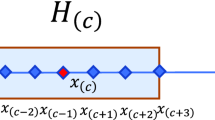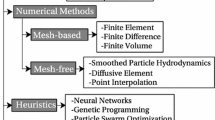Abstract
Differential equations can often be seen in many fields of scientific research and engineering. Typically, finding the analytical (exact) solution is expensive task in terms of computational effort and may not an attainable task for some complex tasks. To effectively handle a wide variety of linear and nonlinear differential equations, this paper presents an approximate methodology based on hybrid Harris hawks–Nelder–Mead optimization algorithm with the aim to achieve accurate and reliable solution. The proposed methodology is introduced on basis of Fourier series expansion and Harris hawks–Nelder–Mead optimization algorithm. In this sense, the differential equation is represented as an optimization model by the means of the weighted residual function (cost function) that needed to be minimized, where the boundary and initial conditions of the differential equation are considered as the constraints of the optimization model. The practicality and efficiency of the proposed algorithm are demonstrated through six differential equations with different nature as well as four mechanical engineering differential equations. The comparison against different algorithms, by using the generational distance metric and Wilcoxon sign rank test, showed the effectiveness of the proposed algorithm.









Similar content being viewed by others
References
Boyce WE, DiPrima RC, Meade DB (2017) Elementary differential equations. John Wiley & Sons
Farlow SJ (1993) Partial differential equations for scientists and engineers. Courier Corporation
de Falco M, Gaeta M, Loia V, Rarità L, Tomasiello S (2016) Differential quadrature-based numerical solutions of a fluid dynamic model for supply chains. Commun Math Sci 14(5):1467–1476
Rarità L, D’Apice C, Piccoli B, Helbing D (2010) Sensitivity analysis of permeability parameters for flows on Barcelona networks. J Differ Equ 249(12):3110–3131
Coşkun SB, Atay MT (2008) Fin efficiency analysis of convective straight fins with temperature dependent thermal conductivity using variational iteration method. Appl Therm Eng 28(17–18):2345–2352
Zhou JK (1986) Differential transformation and its applications for electrical circuits. Huarjung University Press, Wuhan
Domairry G, Fazeli M (2009) Homotopy analysis method to determine the fin efficiency of convective straight fins with temperature-dependent thermal conductivity. Commun Nonlinear Sci Numer Simul 14(2):489–499
Sadollah A, Choi Y, Kim JH (2015) Metaheuristic algorithms for approximate solution to ordinary differential equations of longitudinal fins having various profiles. Appl Soft Comput 33:360–379
Babaei M (2013) A general approach to approximate solutions of nonlinear differential equations using particle swarm optimization. Appl Soft Comput 13(7):3354–3365
Rao SS (2019) Engineering optimization: theory and practice. John Wiley & Sons
Yang XS (2010) Nature-inspired metaheuristic algorithms. Luniver Press
Yang XS (2010) Engineering optimization: an introduction with metaheuristic applications. John Wiley & Sons
Cascone A, Manzo R, Piccoli B, Rarità L (2008) Optimization versus randomness for car traffic regulation. Phys Rev E 78(2):026113(5)
Cutolo A, Nicola CD, Manzo R, Rarità L (2012) Optimal paths on urban networks using travelling times prevision. Model Simul Eng 2012:1–9
D’Apice C, Manzo R, Rarità L (2011) Splitting of traffic flows to control congestion in special events. Int J Math Math Sci 2011:1–18
Rizk-Allah RM (2018) Hybridizing sine cosine algorithm with multi-orthogonal search strategy for engineering design problems. J Comput Des Eng 5(2):249–273
Rizk-Allah RM, Hassanien AE (2018) New binary bat algorithm for solving 0–1 knapsack problem. Complex Intell Syst 4(1):31–53
Rizk-Allah RM (2019) An improved sine–cosine algorithm based on orthogonal parallel information for global optimization. Soft Comput 23(16):7135–7161
Rizk-Allah RM, Hassanien AE, Bhattacharyya S (2018) Chaotic crow search algorithm for fractional optimization problems. Appl Soft Comput 71:1161–1175
Rizk-Allah RM, Hassanien AE, Elhoseny M, Gunasekaran M (2019) A new binary salp swarm algorithm: development and application for optimization tasks. Neural Comput Appl 31(5):1641–1663
Rizk-Allah RM, El-Sehiemy RA, Deb S, Wang GG (2017) A novel fruit fly framework for multi-objective shape design of tubular linear synchronous motor. J Supercomput 73(3):1235–1256
Cao H, Kang L, Chen Y, Yu J (2000) Evolutionary modeling of systems of ordinary differential equations with genetic programming. Genet Program Evolvable Mach 1(4):309–337
Mateescu GD (2006) On the application of genetic algorithms to differential equations. Rom J Econ Forecast 7(2):5–9
Lee ZY (2006) Method of bilaterally bounded to solution blasius equation using particle swarm optimization. Appl Math Comput 179(2):779–786
Heidari AA, Mirjalili S, Faris H, Aljarah I, Mafarja M, Chen H (2019) Harris hawks optimization: algorithm and applications. Future Gener Comput Syst 97:849–872
Kreyszig E (2009) Advanced engineering mathematics, 10th edn. Wiley, New York
Bathe KJ (1996) Finite element procedures seconded, 2nd edn. Prentice Hall, Upper Saddle River
Zitzler E, Thiele L, Laumanns M, Fonseca CM, Da Fonseca VG (2003) Performance assessment of multiobjective optimizers: an analysis and review. IEEE Trans Evol Comput 7(2):117–132
Nelder JA, Mead R (1965) A simplex method for function minimization. Comput J 7(4):308–313
Baghmisheh MV, Peimani M, Sadeghi MH, Ettefagh MM, Tabrizi AF (2012) A hybrid particle swarm–Nelder–Mead optimization method for crack detection in cantilever beams. Appl Soft Comput 12(8):2217–2226
Zahara E, Kao YT (2009) Hybrid Nelder-Mead simplex search and particle swarm optimization for constrained engineering design problems. Expert Syst Appl 36(2):3880–3886
Sadollah A, Eskandar H, Kim JH (2015) Approximate solving of nonlinear ordinary differential equations using least square weight function and metaheuristic algorithms. Eng Appl Artif Intell 40:117–132
Mirjalili S, Mirjalili SM, Lewis A (2014) Grey wolf optimizer. Adv Eng Softw 69:46–61
Mirjalili S (2016) SCA: a sine cosine algorithm for solving optimization problems. Knowl-Based Syst 96:120–133
Sree Ranjini K, Murugan S (2017) Memory based hybrid dragonfly algorithm for numerical optimization problems. Expert Syst Appl 83:63–78
García S, Fernández A, Luengo J, Herrera F (2010) Advanced nonparametric tests for multiple comparisons in the design of experiments in computational intelligence and data mining: experimental analysis of power. Inf Sci 180(10):2044–2064
Author information
Authors and Affiliations
Corresponding author
Additional information
Publisher's Note
Springer Nature remains neutral with regard to jurisdictional claims in published maps and institutional affiliations.
Rizk M. Rizk-Allah, Aboul Ella Hassanien: Scientific Research Group in Egypt http://www.egyptscience.net.
Rights and permissions
About this article
Cite this article
Rizk-Allah, R.M., Hassanien, A.E. A hybrid Harris hawks-Nelder-Mead optimization for practical nonlinear ordinary differential equations. Evol. Intel. 15, 141–165 (2022). https://doi.org/10.1007/s12065-020-00497-3
Received:
Revised:
Accepted:
Published:
Issue Date:
DOI: https://doi.org/10.1007/s12065-020-00497-3




